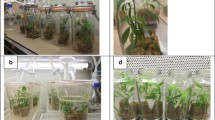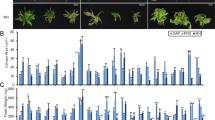Abstract
Global demands for an in vitro culture of cannabis have never been more sought after as countries shift their paradigm towards legalization. Cannabis conventional (photomixotrophic) micropropagation has not been suitable enough for large-scale propagation due to a high degree of plant hyperhydricity, low growth rate, poor rooting, and acclimation efficiency. In the present study, cannabis photoautotrophic micropropagation method is introduced with the purpose of overcoming the difficulties that conventional micropropagation entails when conducted at a large scale. The roles of rockwool medium pH and moisture content, cutting length, basal wounding methods, light intensity, and culture vessel gas exchange capacity were assessed with the intention of increasing productivity of micropropagation method. The results showed 300 mL per vessel of fertilizer solution containing 5-mM MES buffer stabilized medium pH and increased rooting success. Both 5- and 7-cm cutting lengths significantly increased the percent of rooted plants compared to 3-cm cutting length. However, the basal wounding methods did not significantly improve or impede the rooting success. The highest rooting success was also obtained with 150 μmol m−2 s−1 of photosynthetic photon flux density compared to 50 and 100 μmol m−2 s−1. Increasing gas exchange rates either using more permeable vessels or aeration practices significantly improved the rooting success. Overall, more than 90% of cannabis plantlets grown in photoautotrophic micropropagation are rooted in 2 wk of culture followed by 4 d ex vitro acclimation period, which was remarkably shorter than any other available method in cannabis micropropagation. This study not only optimizes a method for cannabis photoautotrophic micropropagation using passive ventilation for the first time but also scales up in vitro clonal propagation for in vitro commercial production.





Similar content being viewed by others
References
Aeschbacher RA, Schiefelbein JW, Benfey PN (1994) The genetic and molecular basis of root development. Annu Rev Plant Physiol Plant Mol Biol 45:25–45. https://doi.org/10.1146/annurev.pp.45.060194.000325
Amoah FM (2006) Review of vegetative propagation of cacao (Theobroma cacao L.) by rooted cuttings. 2. Environmental and technical considerations. Ghana J Agri Sci 39:217–226. https://doi.org/10.4314/gjas.v39i2.2144
Campbell LG, Naraine SGU, Dusfresne J (2019) Phenotypic plasticity influences the success of clonal propagation in industrial pharmaceutical Cannabis sativa. PLoS One 3:e0213434. https://doi.org/10.1371/journal.pone.0213434
Chaohua C, Gonggua Z, Lininga Z, Chunshenga G, Qinga T, Jianhuaa C, Xinbob G, Dingxiangc P, Jianguanga S (2016) A rapid shoot regeneration protocol from the cotyledons of hemp (Cannabis sativa L.). Ind Crop Prod 83:61–65. https://doi.org/10.1016/j.indcrop.2015.12.035
Cranshaw WS, Halbert SE, Favret C, Britt KE, Miller GL (2018) Phorodon cannabis Passerini (Hemiptera: Aphididae), a newly recognized pest in North America found on industrial hemp. Insecta Mundi 0662:1–12
Cranshaw W, Schreiner M, Britt K, Kuhar TP, McPartland J, Grant J (2019) Developing insect pest management systems for hemp in the United States: a work in progress. J Integ Pest Manag 10:1–11. https://doi.org/10.1093/jipm/pmz023
Cui Y, Hahn E, Kozai T, Paek K (2000) Number of air exchanges, sucrose concentration, photosynthetic photon flux, and differences in photoperiod and dark period temperatures affect growth of Rehmannia glutinosa plantlets in vitro. Plant Cell Tiss Org Cult 62:219–226
Desjardins Y, Laforge F, Lussier C, Gosselin A (1988) Effect of CO2 enrichment and high photosynthetic photon flux on the development of authothrophy and growth of tissue-cultured strawberry, raspberry and asparagus plant. Acta Hortic (230):45–54
Eriksen EN (1973) Root formation in pea cuttings. I. Effects of decapitation and disbud-ding at different development stages. Physiol Plant 28:503–506
Erstad JLF, Gislerød HR (1994) Water uptake of cuttings and stem pieces as affected by different anaerobic conditions in the rooting medium. Sci Hortic 58:151–160
Fujiwara K, Kozai T, Watanabe I (1988) Development of a photoautotrophic tissue culture system for shoots and/or plantlets at rooting and acclimation stages. Acta Hortic 23:153–158
Government of Canada (2019) Cannabis legalization and regulation. [Online]. Retrieved July 2, 2019, https://www.justice.gc.ca/eng/cj-jp/cannabis/. Accessed July 2020
Hartmann HT, Kester DE, Davies FT, Geneve RL (2014) Hartmann & Kester’s plant propagation: principles and practices. Pearson Education Limited, Harlow
Health Canada (2020) Licensed cultivators, processors and sellers of cannabis under the Cannabis Act. https://www.canada.ca/en/health-canada/services/drugs-medication/cannabis/industry-licensees-applicants/licensed-cultivators-processors-sellers.html#wb-auto-6
Kodym A, Leeb CJ (2019) Back to the roots: protocol for the photoautotrophic micropropagation of medicinal Cannabis. Plant Cell Tiss Org Cult 138:399–402. https://doi.org/10.1007/s11240-019-01635-1
Kozai T (2010) Photoautotrophic micropropagation – environmental control for promoting photosynthesis. Propag Ornam Plant 10:188–204
Kozai T, Afreen F, Zobayed SMA (2005) Photoautotrophic (sugar-free medium) micropropagation as a new propagation and transplant production system. Springer, Dordrecht, 315 pp
Kozai T, Iwanami Y (1988) Effect of CO2 enrichment and sucrose concentration under light photon fluxes on plantlet growth of carnation (Dianthus caryophyllus L.) in tissue culture during the preparation stage. J Japan Soc Hort Sci 57:279–288
Kozai T, Koyama Y, Watanabe I (1988) Multiplication and rooting of potato plantlets in vitro with sugar medium under high photosynthetic photon flux. Acta Hortic 230:121–127
Kozai T, Nguyen QT (2003) Photoautotrophic micropropagation of woody and tropical plants. In: Jain SM, Ishii K (eds) Micropropagation of Woody Trees and Fruits. Forestry Sciences, vol 75. Springer, Dordrecht, pp 757–781. https://doi.org/10.1007/978-94-010-0125-0_26
Kozai T, Xiao Y (2008) A commercialized photoautotrophic micropropagation system. In: Gupta SD, Ibaraki Y (eds) Plant Tiss Cult Engr Focus on Biotechnology, vol 6. Springer, Dordrecht. https://doi.org/10.1007/978-1-4020-3694-1_19
Lata H, Chandra S, Khan I, ElSohly MA (2009) Thidiazuron-induced high-frequency direct shoot organogenesis of Cannabis sativa L. In Vitro Cell Dev Biol - Plant 45:12–19. https://doi.org/10.1007/s11627-008-9167-5
Lata H, Chandraa S, Techena N, Khana IA, ElSohly MA (2016) In vitro mass propagation of Cannabis sativa L.: a protocol refinement using novel aromatic cytokinin meta-topolin and the assessment of eco-physiological, biochemical and genetic fidelity of micropropagated plants. J Appl Res Med Aromatic Plant 3:18–26. https://doi.org/10.1016/j.jarmap.2015.12.001
MacKenzie KAD, Howard BH, Harrison-Murray RS (1986) The anatomical relationship between cambial regeneration and root initiation in wounded winter cuttings of the apple rootstock M.26. Ann Bot 58:649–661
Meier U (2006) A note on the power of Fisher’s least significant difference procedure. Pharm Stat 4-5:249–252. https://doi.org/10.1002/pst.210
Ministry of Environment and Climate Change Strategy (2019) Integrated pest management for commercial cannabis in BC. https://www2.gov.bc.ca/assets/gov/environment/pesticides-and-pest-management/business-and-industry/integratedpestmanagement_cannabis_manual_web.pdf. ()
Mosaleeyanon K, Cha-um S, Kirdmanne C (2004) Enhanced growth and photosynthesis of rain tree (Samanea saman) plantlets in vitro under CO2 enrichment with decreased sucrose concentration in the medium. Scientia Hort 103:51–63
Nguyen MT, Nguyen QT, Nguyen UV (2008) Effects of light intensity and CO2 concentration on the in vitro and ex vitro growth of strawberry (Fragaria ananassa Duch.). J Biotechnol 6:233–239 (in Vietnamese with English abstract)
Nguyen QT, Kozai T (2001) Growth of in vitro banana (Musa spp.) shoots under photomixotrophic and photoautotrophic conditions. In Vitro Cell Dev Biol - Plant 37:824–829
Nguyen QT, Xiao Y, Kozai T (2016) Photoautotrophic micropropagation. In: Kozai T, Niu G, Takagaki M (eds) Plant Factory. Academic Press, Burlington, pp 271–283
Nguyen TQ, Kozai T, Nguyen KL, Nguyen UV (1999) Effects of sucrose concentration, supporting material and number of air exchange of the vessel on the growth of in vitro coffee plantlets. Plant Cell Tiss Org Cult 58:51–57
Page SRG, Monthony AS, Jones AMP (2020) Basal media optimization for the micropropagation and callogenesis of Cannabis sativa L. bioRxiv. doi: https://doi.org/10.1101/2020.02.07.939181
Piunno KF, Golenia G, Boudko EA, Downey C, Jones AMP (2019) Regeneration of shoots from immature and mature inflorescences of Cannabis sativa. Can J Plant Sci 99:1–4. https://doi.org/10.1139/cjps-2018-0308
Potter DJ (2009) The propagation, characterisation and optimisation of Cannabis sativa L. as a phytopharmaceutical. Ph.D. thesis. King’s College London, London 255 pp
Punja ZK (2018) Flower and foliage-infecting pathogens of marijuana (Cannabis sativa L.) plants. Can J Plant Pathol 40:514–527. https://doi.org/10.1080/07060661.2018.1535467
Punja ZK, Collyer D, Scott C, Lung S, Holmes J, Sutton D (2019) Pathogens and molds affecting production and quality of Cannabis sativa L. Front Plant Sci 10:1120. https://doi.org/10.3389/fpls.2019.01120
Quarles W (2018) IPM for Cannabis Pests. In: The IPM practitioner monitoring the field of pest manag, vol 36, pp 1–7 https://www.birc.org/IPMPCannabis.pdf
R Core Team (2019) R: a language and environment for statistical computing. R Foundation for Statistical Computing, Vienna
Robert HS, Friml J (2009) Auxin and other signals on the move in plants. Nat Chem Biol 5:325–332
Smýkalová I, Vrbová M, Cvečková M, Plačková L, Žukauskaitė A, Zatloukal M, Hrdlička J, Plíhalová L, Doležal K, Griga M (2019) The effects of novel synthetic cytokinin derivatives and endogenous cytokinins on the in vitro growth responses of hemp (Cannabis sativa L.) explants. Plant Cell Tiss Org Cult 139:381–394. https://doi.org/10.1007/s11240-019-01693-5
Soffer H, Burger DW (1988) Effects of dissolved oxygen concentrations in aero hydroponics on the formation and growth of adventitious roots. J Am Soc Hortic Sci 113:218–221
Statistics Canada (2020) Table 36-10-0599-01 Cannabis industry production account (x 1,000,000). https://www150.statcan.gc.ca/t1/tbl1/en/tv.action?pid=3610059901, ()
Wang R, He LS, Xia B, Tong JF, Li N, Peng F (2009) A micropropagation system for cloning of hemp (Cannabis sativa L.) by shoot tip culture. Pak J Bot 41:603–608
Xiao Y, Niu G, Kozai T (2011) Development and application of photoautotrophic micropropagation plant system. Plant Cell Tiss Org Cult 105:149–158. https://doi.org/10.1007/s11240-010-9863-9
Acknowledgements
The authors gratefully thank two NRC Industrial Technology Advisors Mr. Hugh Scholaert and Mr. Ron Evans for their constructive advices, connections, and supports.
Funding
Financial support for this research was provided in part by National Research Council of Canada (NRC), Industrial Research Assistance Program (NRC_IRAP, Project No. 944131).
Author information
Authors and Affiliations
Corresponding author
Ethics declarations
Competing Interests
The authors declare no conflict of interest.
Additional information
Editor: David Songstad
Supplementary Information
ESM 1
(DOCX 3325 kb)
Rights and permissions
About this article
Cite this article
Zarei, A., Behdarvandi, B., Tavakouli Dinani, E. et al. Cannabis sativa L. photoautotrophic micropropagation: a powerful tool for industrial scale in vitro propagation. In Vitro Cell.Dev.Biol.-Plant 57, 932–941 (2021). https://doi.org/10.1007/s11627-021-10167-3
Received:
Accepted:
Published:
Issue Date:
DOI: https://doi.org/10.1007/s11627-021-10167-3




